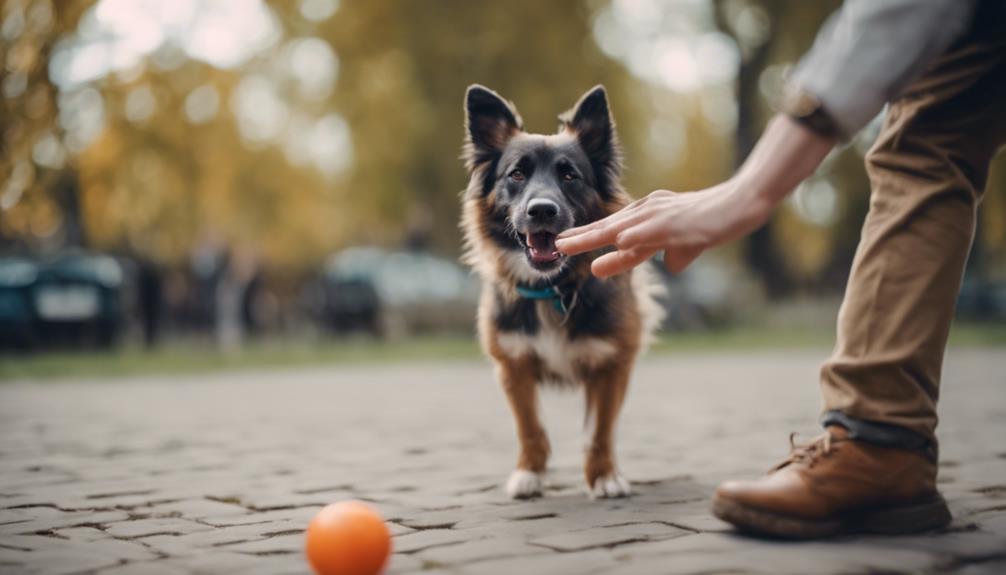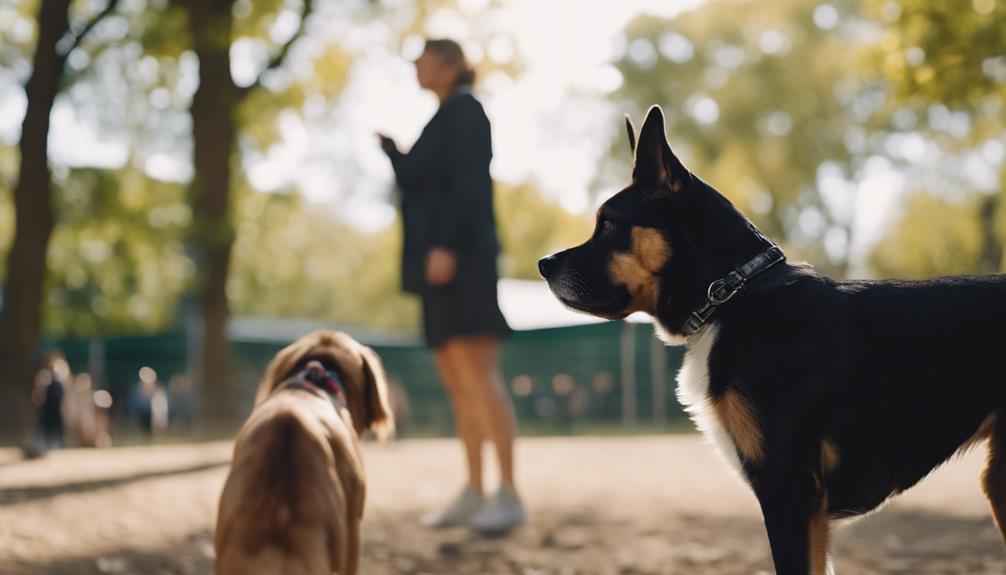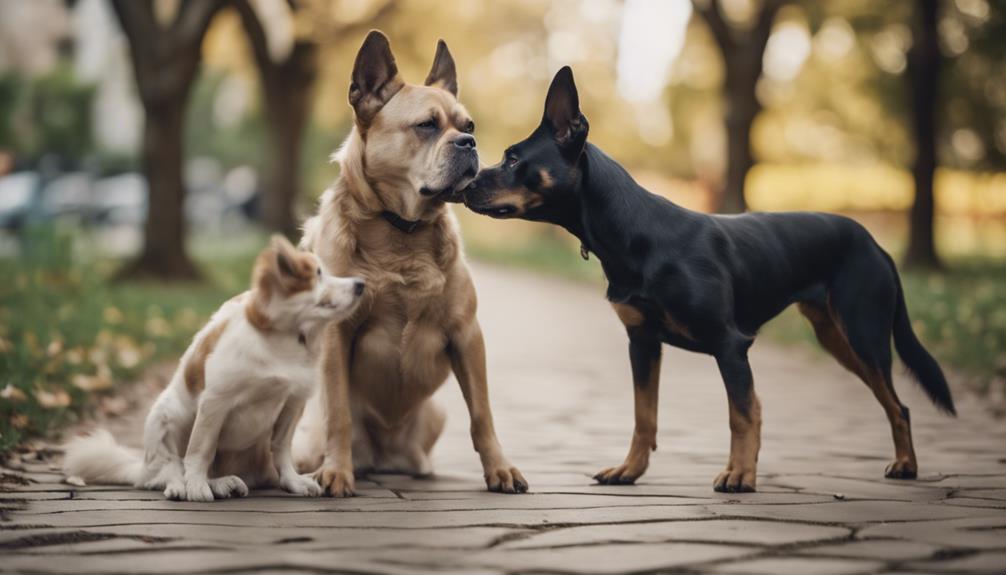The act of dogs sniffing each other's behinds is a fascinating aspect of canine behavior that has intrigued pet owners for generations. While this behavior may seem perplexing to human observers, it plays a crucial role in canine communication and social dynamics.
However, what should you do if your dog takes this natural behavior to the level of a 'privates investigator'? Understanding the reasons behind this behavior and learning effective strategies to manage it can significantly impact your dog's social interactions and overall well-being.
Stay tuned to uncover insightful tips on navigating your dog's investigative tendencies and promoting healthy canine relationships.
Key Takeaways
- Dogs sniff butts to gather information and greet each other politely.
- Redirect your dog's behavior with known cues like 'Come' or 'Sit' if they are overly nosy.
- Prolonged sniffing or aggression between dogs should be monitored and addressed.
- Understanding canine social interactions and communication cues is essential for responsible pet ownership.
Canine Greeting Rituals
Dogs engage in intricate greeting rituals through scent, using their powerful sense of smell to communicate and gather essential information about one another. Sniffing is a natural behavior for dogs, akin to a handshake for humans.
When dogs meet, they exchange vital information through scent glands located in their anal region, which contain pheromones unique to each dog. This sniffing ritual helps dogs establish familiarity, detect emotions, identify gender, and even determine health status.
Through this olfactory communication, dogs can assess whether the other dog is approachable, friendly, or a potential threat. Understanding the significance of this scent-driven greeting behavior is crucial for interpreting canine social interactions accurately.
The Power of Canine Olfaction
Canine olfaction, the sense of smell in dogs, plays a pivotal role in their communication and understanding of the world around them. Dogs rely heavily on their sense of smell to gather information and make sense of their environment. This remarkable olfactory ability allows them to perceive the world in ways that humans cannot comprehend.
Some fascinating aspects of the power of canine olfaction include:
- Dogs can detect certain diseases in humans through their scent.
- They can differentiate identical twins based on their unique odors.
- Dogs can locate missing persons or detect drugs and explosives with their keen sense of smell.
- Their olfactory prowess enables them to perceive emotions and intentions in humans and other animals.
Redirection Techniques for Dogs

Utilizing known cues and engaging in alternative activities can effectively redirect unwanted behaviors in dogs. When a dog exhibits behaviors such as excessive sniffing, barking, or licking, redirection techniques can be valuable tools for pet owners.
By using cues like 'Come,' 'Watch me,' 'Sit,' 'Fetch,' or 'Touch/hand targeting,' you can shift your dog's focus onto a more appropriate activity. Additionally, engaging your dog in other activities such as playing with toys, going for a walk, or practicing obedience commands can help redirect their attention away from undesirable behaviors.
These redirection tactics not only prevent rudeness or nosiness in social interactions but also provide mental stimulation and reinforce positive behaviors in your canine companion.
Canine Social Etiquette
Upon observing proper canine social etiquette, pet owners can ensure harmonious interactions among dogs in various social settings. It is crucial to understand and respect the natural behaviors and communication methods of dogs to facilitate positive social interactions. To promote good canine social etiquette, consider the following:
- Allow dogs to greet each other through sniffing, a natural and polite behavior.
- Monitor interactions to ensure that sniffing remains brief and non-threatening.
- Intervene if sniffing becomes prolonged or escalates into aggressive behavior.
- Redirect attention or use calming techniques if necessary to maintain a peaceful social environment.
Monitoring Dog Interactions

Effective monitoring of dog interactions is essential for ensuring safe and harmonious social engagements among canine companions.
When dogs interact, it is crucial to observe their body language, vocalizations, and overall behavior. Normal interactions such as sniffing each other can be brief and serve as a way for dogs to gather information.
However, prolonged sniffing or aggressive behaviors should be carefully monitored and addressed promptly. Signs of aggression, like growling or raised hair, require intervention through redirection tactics to prevent escalation.
By closely monitoring dog interactions, pet owners can ensure that their dogs engage positively with others, promoting a healthy social environment and preventing potential conflicts.
Regular supervision and proactive intervention can contribute to fostering respectful and enjoyable interactions among dogs.
Understanding Dog Barking
A comprehensive understanding of dog barking is pivotal for interpreting and responding to canine communication effectively. Dogs bark for various reasons, and deciphering the message behind the bark can enhance the bond between humans and their furry companions.
Here are some key points to consider when it comes to understanding dog barking:
- Dogs bark to communicate with other dogs and humans.
- Barking can signal excitement, fear, or a need for socialization.
- The context of the bark, along with body language, provides insights into a dog's emotional state.
- Different types of barks, such as playful barks or warning barks, convey distinct messages that require interpretation.
Managing Excessive Barking

Understanding dog barking lays the foundation for effectively managing excessive barking behaviors in canine companions. Excessive barking can stem from various reasons such as boredom, fear, excitement, territorial behavior, or seeking attention.
To manage excessive barking, it is essential to identify the root cause triggering the behavior. Providing mental and physical stimulation through activities like walks, interactive toys, and training sessions can help alleviate boredom and excess energy, reducing the need for excessive barking.
Positive reinforcement training techniques can also be utilized to teach alternative behaviors and reward quiet moments. Consistent training, patience, and understanding your dog's individual needs are key in successfully managing and reducing excessive barking in your furry friend.
Deciphering Dog Communication Cues
Interpreting a dog's body language is crucial for understanding their communication cues accurately. Dogs use a combination of body movements, facial expressions, and vocalizations to convey their feelings and intentions to humans and other animals.
To decode these signals effectively, consider the following cues:
- Tail wagging: The speed, height, and direction of the wag can indicate different emotions.
- Ear position: Erect ears show alertness, while flattened ears can signal fear or submission.
- Eye contact: Staring can be perceived as a challenge, while avoiding eye contact may indicate discomfort.
- Posture: A relaxed, loose posture suggests a calm and friendly state, whereas stiffness may signal tension or aggression.
Interpreting Dog Behavior

Analyzing dog behavior provides insight into their needs and emotions. By observing a dog's body language, vocalizations, and interactions with others, owners can better understand their pet's state of mind.
For example, a wagging tail may indicate happiness or excitement, while flattened ears could signal fear or anxiety. Additionally, paying attention to a dog's overall demeanor, such as their energy levels and appetite, can offer clues about their well-being.
Understanding common canine behaviors like sniffing, barking, and play can help decipher what a dog is trying to communicate. By interpreting these behaviors accurately, owners can respond appropriately to their dog's needs and strengthen the bond between them.
Affectionate Dog Licking Behaviors
Dogs exhibit various forms of affection through their licking behaviors, which serve as a means of communication and bonding with their owners. While licking is a common behavior, it can convey different messages based on the context and the dog's personality.
Here are some reasons behind a dog's affectionate licking:
- Showing Love: Dogs lick to express their love and strengthen the bond with their owners.
- Seeking Attention: Licking can be a way for dogs to seek attention or affection from their human companions.
- Submission and Respect: Some dogs lick as a sign of submission or to show respect towards their owners.
- Grooming Behavior: Licking can also mimic the grooming behavior seen in packs, where dogs help keep each other clean and free of pests.
Signs of Stress in Dogs

Recognizing signs of stress in dogs is crucial for responsible pet owners to ensure the well-being and health of their canine companions. Common signs of stress in dogs include excessive barking, whining, panting, pacing, trembling, yawning, and avoidance behaviors.
Other indicators may include destructive behavior, such as chewing furniture or shoes, as well as changes in appetite or elimination habits. Additionally, dogs may display signs of stress through aggression, such as growling, snapping, or biting. It is essential to observe your dog's body language and behavior closely to identify these signs early on.
Addressing stress in dogs promptly through appropriate measures, such as providing a quiet and safe space, regular exercise, mental stimulation, and positive reinforcement, can help alleviate their anxiety and promote overall well-being.
Addressing Dog Anxiety
Upon observing signs of stress in dogs, it becomes imperative to address and alleviate their anxiety through effective strategies tailored to their individual needs. Dogs, like humans, can experience anxiety for various reasons, and it is essential to provide them with the support they need to feel calm and secure.
Here are some strategies to help address dog anxiety:
- Establish a routine to provide a sense of predictability and security.
- Create a safe space or den-like area where your dog can retreat when feeling overwhelmed.
- Engage in regular exercise and mental stimulation to help reduce anxiety levels.
- Consider using calming aids such as pheromone diffusers or calming music to promote relaxation.
Preventing Behavioral Issues

To mitigate potential behavioral issues in canine companions, proactive training and socialization are essential components of responsible pet ownership. By establishing clear boundaries, providing mental stimulation, and offering positive reinforcement, pet owners can address and prevent unwanted behaviors effectively. Here are some key strategies to prevent behavioral issues in dogs:
| Preventive Strategies | Description |
|---|---|
| Consistent Training | Regular training sessions help reinforce good behavior and establish a strong bond between the dog and owner. |
| Socialization | Exposing dogs to various environments, people, and animals from a young age can prevent fear-based aggression and anxiety. |
| Physical Exercise | Sufficient exercise helps in burning off excess energy, reducing boredom, and preventing destructive behaviors. |
| Mental Stimulation | Engaging activities like puzzle toys, interactive games, and training exercises can prevent behavioral issues stemming from boredom or under-stimulation. |
>Can Excessive Sniffing and Investigating Cause Aggressive Behavior in Dogs?
Excessive sniffing and investigating can sometimes lead to aggressive behavior in dogs. Using vetapproved puppy biting tactics can help address and prevent these behaviors. It’s important to understand your dog’s body language and reactions to avoid potential aggression triggers. Training and patience are key in correcting this behavior.
Conclusion
In conclusion, understanding the significance of dogs sniffing each other's behinds as a form of communication and information exchange is crucial for fostering healthy social interactions among canines.
By recognizing the power of canine olfaction and implementing redirection techniques when necessary, dog owners can effectively manage their dog's investigative tendencies and promote positive social etiquette.
Monitoring dog interactions, addressing signs of stress and anxiety, and preventing behavioral issues are key steps in ensuring a harmonious relationship between dogs and their human companions.




